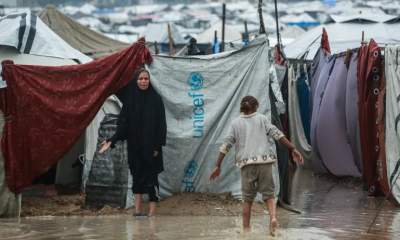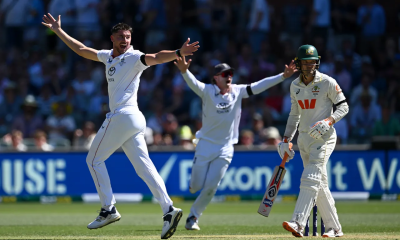Features
Challenges in meeting President’s target

Development of renewable energy projects II –
By Dr Janaka Ratnasiri
The comments made by the President at the meeting he had on 15.12.2020 to discuss the development of renewable energy (RE) projects were highlighted in recent media reports, as described in the writer’s earlier write-up which appeared in The Island of 28.12.2020 under the same heading. However, there was no reference in these reports to any feedback that would have been made by officials present. The purpose of this write-up is to discuss likely issues that would have been of concern to institution officials and the challenges they may have to face in meeting the President’s target.
FEARS OF DESTABILIZING THE SYSTEM
The first challenge is to change the mindset of professionals concerned. Energy experts both within the Ceylon Electricity Board (CEB) and outside have been saying for years that connecting too many of RE plants such as wind and solar power systems to the grid will cause its destabilization, not being able to maintain the voltage and the frequency within permitted limits. The output of these RE supplies keep fluctuating momentarily, hourly and diurnally and the problem is how to balance the supply and load under such dynamic conditions. It was also said that excess harmonics generated during conversion of direct current (DC) output from solar systems or from DC wind turbines into alternating current (AC) for feeding into the grid could degrade the quality of the supply.
According to a website on RE systems, “Impacts caused by high penetration levels of intermittent renewable distributed generation can be complex and severe and may include voltage increase, voltage fluctuation, interaction with voltage regulation and control equipment, reverse power flows, temporary overvoltage, power quality and protection concerns, and current and voltage unbalance, among others. The uncertainty and intermittency of wind and solar generation are major complications that must be addressed before the full potential of these renewables can be reached”. These challenges require advanced control strategies to solve the problems effectively.
PROBLEMS ASSOCIATED WITH RENEWABLE ENERGY SYSTEMS
One problem associated with RE systems is that they are not considered dispatchable, which means that their output is not available as and when necessary, unlike in the case of thermal power plants. Wind power output is available only when wind blows which keeps changing in a stochastic manner hourly, diurnally and seasonally. In Sri Lanka, wind is generally strong during the second half of the year than in the first half. In the case of solar panels, their output is available only during the daytime peaking at noon and declining with the increasing solar angle. Even during daytime, the output would drop if there is cloud cover or rainfall. If there is extended periods of bad weather, a consumer has to depend on some back-up power.
According to the CEB Chairman’s Review given in its 2018 Annual Report, “a study on Integration of Renewable Based Generation into Sri Lankan Grid 2020-2030 was conducted during the year (2018) with the objective of investigating the main challenges faced in renewable energy-based generation and determining the optimum level of renewable energy generation”. However, there is no report of this study available in the CEB’s website.
STORAGE SYSTEMS FOR RENEWABLE ENERGY PLANTS
In order to make use of solar energy that is generated during the day, at night time, it is necessary to store the electricity by suitable means. This also applies to wind energy to even out the fluctuating output into a steady output. If the system is connected to the grid, energy generated by solar systems during the day or by wind systems when the wind blows can be fed into the grid and the grid provides the electricity to the consumer during night time or when there is no wind blowing. Hence, there is no need for a separate storage facility with grid-connected systems.
For large scale solar systems, one method of storage is to make use of exiting hydro power reservoirs by saving the water which would have been used for generating an equivalent amount of energy generated by solar panels during the day, and using the water saved during night time. This does not require any additional expenditure on building extra facilities. Another is to build pump-storage facilities comprising two sets of reservoirs at two elevations connected via a penstock with a generator/pump system at the bottom. Already one such system is being planned at Aranayaka.
Any surplus energy generated during the day from solar panels or when wind blows is made use of to pump water from the lower reservoir to the upper reservoir. At night time or when there is no wind, the pumped water is allowed to flow down the penstock driving the pump in the reverse mode to generate electricity. In the West, such pump-storage systems have been used for many decades for peaking purposes. One good example is the system installed at the Niagara Falls.
HYDROGEN SYSTEMS FOR STORAGE
Another method available is to feed the solar panel output to a set of electrolyzers, which are available commercially today, to generate hydrogen by splitting water. Hydrogen generated is stored and fed to a bank of fuel-cells to generate electricity in the form of direct current (DC) and later inverted to AC. After filtering out harmonics, this steady output is fed to the grid as and when necessary, day or night, using the stored hydrogen which makes it dispatchable. Each solar or wind or hybrid energy park that is being planned could be supplemented by such hydrogen storage system accompanied by a bank of fuel cells, enabling the output from these RE parks dispatchable.
There is much interest among developed countries to develop hydrogen energy systems. European Union has set out plans which could require up to € 470 billion (USD 570 billion) of investment in green hydrogen by 2050. Germany alone is targeting 5,000 MW of electrolysis capacity by 2030. Japan, a front-runner along with South Korea, is looking to sharply increase a target to import 300,000 tonnes a year of hydrogen in 2030. U.S. President Joe Biden wants to fund research into technology, including large-scale electrolyzers, to help make green hydrogen costs match conventional hydrogen within a decade. (https://energy.economictimes.indiatimes.com/news/renewable/explainer-why-green-hydrogen-is-finally-getting-its-day-in-the-sun/79672523).
PROPOSAL FOR ROOF-TOP SOLAR INSTALLATIONS
The 2021 Budget Speech states that a capacity of 500 MW will be added to the grid, by providing solar panels each generating 5 kW, to 100,000 houses of low-income families. At the meeting the President had on 15.12.2020 with the two Ministers and Ministry officials, he has said that the Government would bear the cost of LKR. 800,000 per house for installing solar cell panels under this project. This means the expenditure on this project will be about LKR 80 billion. The question arises who will be responsible for implementing this project? The SLSEA Act grants powers to it for “entertainment of applications for carrying on of on-grid and off-grid renewable energy projects”. It also has powers for “the development of guidelines on renewable energy projects and disseminating them among prospective investors”. Hence, the SLSEA may be assigned the task of coordinating the project.
The purchase of 100,000 roof-top panels and getting them installed is a challenge by itself. There is a large number of local companies, numbering about 200, involved in supplying and installing roof-top solar panels. The government should call for expressions of interest (EOI) from these companies to undertake this assignment requesting information on their track record and proof of their ability and competency. Next, bids need to be invited from selected companies after announcing detailed specifications for the panels.
It is important to specify in the bid document itself the limiting values for key parameters with tolerances that need to be met by the panel offered, without just saying that panels offered should conform to international standards, as normally done by the CEB. The evaluation of the bids would be much simpler and faster then. It is best if the supply is distributed among as many vendors as possible, after agreeing on a fixed price, to expedite the implementation of the project and avoid complaints from unsuccessful bidders.
POOR PLANNING FOR RENEWABLE ENERGY PROJECTS
Though the Cabinet of Ministers since 2016 has been taking decisions to introduce RE projects including solar power systems at both domestic level and utility scale, their follow up by the two implementing agencies, viz. SLSEA and the CEB has been rather slow, possibly due to divided responsibility. According to the SLSEA Act, any RE project needs the approval of the SLSEA before commencing any work.
The Electricity Act also requires accepting projects selected only after calling for tenders except those recommended by the SLSEA. The misinterpretation of the Electricity has resulted in projects recommended by the SLSEA getting held up by the CEB for extended periods. The CEB’s draft LTGE Plan for 2020-39 prepared in May 2019, plans to add only 165 MW of mini-hydro systems, 555 MW of wind systems, 880 MW of solar systems and 55 MW of biomass systems up to 2030. Even the SLSEA has failed to come out with a plan to develop RE systems in an optimal manner as highlighted in the Writer’s article in the Island of 28.12.2020.
This is despite the fact that the previous Cabinet decisions had wanted about 2,000 MW of solar power added within a shorter time frame, comprising 1000 MW of roof-top systems and 1000 MW of utility systems. As mentioned in the previous article, even the SLSEA has failed to come up with a plan to develop RE systems though it is a requirement given in its Act. So, another challenge is to get the CEB and SLSEA to enhance their plans for RE generation and fall in line with the Government policy. If they do not comply, the solution is not closing down of the PUCSL as highlighted in writer’s article in The Island of 25.12.2020. (See https://island.lk/cabinet-discussion-on-public-utilities-commission/)
INCOMPATIBILITY OF NEW COAL POWER PLANTS WITH INCREASED RE SHARE
One problem possibly encountered in increasing the RE share is the incorporation of several new coal power plants in the system by 2030. This increases the share of fossil fuel share leaving only a small fraction to be filled by RE systems. For example, the draft Plan for 2020-39 shows the demand in 2030 as 31,740 GWh, out of which 20,640 GWh (65%) will be from fossil fuels and 11,100 GWh (35%) from RE sources. Out of the 20,640 GWh expected from fossil fuel plants, 7,721 GWh (24%) will be from the two new coal power plants to be built at Norochcholai (600 MW) and Trincomalee (300 MW). Another 4,781 GWh (15%) will be from the existing coal power plant at Norochcholai.
This means by 2030, 12,502 GWh (39%) of the demand will be met from coal while another 8,140 GWh (26%) will be from oil or jointly 20,640 GWh (65%) from fossil fuels. If 70% of total demand is to be met from renewables, then only 30% could be generated from fossil fuels. This means that the RE contribution has to be 48,160 GWh if the fossil fuel contribution is to be maintained at 20,640 GWh, making the total supply to be 68,800 GWh, which is more than double the forecasted demand in 2030. In order to make achieving of 70% share from RE sources feasible, it is therefore imperative to limit the fossil fuel contribution to 9,520 GWh in order to maintain the total supply at 31,740 GWh.
The easiest way to achieve this target is to stop building the two new coal power plants at Norochcholai and at Trincomalee, and retire the 20-year-old existing coal plant at Norochcholai. Hence, building new coal power plants is not compatible with President’s target on RE share of 70% in electricity generation. The President should therefore give a clear directive to CEB to discontinue planning of new coal power plants disregarding what its Unions say.
It is reported in the media that a former Army Officer has been appointed as Vice-Chairman of CEB to help CEB “to achieve President Gotabaya Rajapaksa’s of goal promoting renewable energy and providing electricity at a minimal cost” (Island of 22.12.2020). Perhaps the new Vice-Chairman will keep those within CEB who oppose President’s move at bay, including the trade unions.
IMPROVING RESEARCH CAPABILITY OF CEB
According to the CEB Act of 1969, CEB has powers to conduct research into matters affecting the generation, distribution, transmission, supply and use of electricity (Article 12h). However, CEB’s Annual Reports do not refer to any research being done within the CEB. Students in the Physical Science stream having the highest scores at GCE (A level) examination get admitted to engineering courses and those who follow electrical engineering ending up in institutions like CEB.
It is a pity that the CEB management does not make use of this talented graduates to undertake research to seek solutions to such problems such as integrating RE systems into the grid, develop new storage systems and to provide other research and development support for RE systems. In 2019, the CEB has spent about LKR 97 Billion on importing fuel for thermal power plants (SD 2019).
With the introduction of large scale RE systems, part of this expenditure could be saved which could be utilized to set up a Research and Development (R&D) Division in CEB as provided for in its Act.
Perhaps, a senior academic with research experience in RE systems could be invited to set up the R&D Division and provide him with a team of young engineers comprising both electrical and ICT engineers with aptitude for research to undertake studies on how to make the grid smart as described above.
THE WAY FORWARD
If the full potential of the country’s RE resources is exploited, it will be possible to achieve the entire electricity generation from RE sources. It will also save hundreds of Billions of Rupees annually on importing fuel required for operating thermal power plants. However, there are many problems to surmount before this could be achieved. Among these are the following:
a. Change the mindset of senior officials controlling the power sector that changing from fossil fuels to RE sources to meet the base load requirements is technically feasible.
b. Discontinue building new coal power plants and retire the existing coal power plant by 2030 as their presence will exceed the 30% share from fossil fuels.
c. Introduce mechanisms for energy storage at utility scale through utilizing existing hydro power reservoirs or building pump-storage systems or adding large batteries or adding electrolyzer-fuel cell systems which are commercially available now.
d. Set up a R&D Division within CEB to seek solutions for problems associated with integration of utility scale RE systems into the grid.
e. Entertain investors directly for RE projects on build, own, operate and transfer (BOOT) basis by providing efficient, clear and transparent mechanism for accepting proposals and guaranteeing security of their investments.
f. Publish a set of guidelines prepared jointly by SLSEA, CEB and PUCSL for accepting and approving candidate RE projects proposed by investors on BOOT basis.
CONCLUSION
It is important for decision makers to take a wholistic view of the power sector in the country and take evidence-based decisions rather than taking a piecemeal approach. It is not possible to build more coal power plants on one hand and fix targets for increased RE share on the other. While the President wants more renewable energy projects, the Ministry and CEB want more coal power plants. The President should decide on his priorities. If his priority is to have more renewable energy share by 2030, then he should get CEB to give up building more coal power plants. He cannot have both. It is his biggest challenge.
Features
How the ‘Lost Tribes of Israel’ help in understanding Mid-East peace issues

 Reports that the Israeli authorities have given the ‘go ahead’ for the repatriation and integration into the Israeli populace of some survivors in parts of India from what are described as the ‘Lost Tribes of Israel’, bring up a subject that merits continuous and focused research. The contemporary observer of international politics seeking to understand more thoroughly the factors fueling the Middle East conflict and the crucial role identity issues play in it would, no doubt, be the biggest beneficiary of such research.
Reports that the Israeli authorities have given the ‘go ahead’ for the repatriation and integration into the Israeli populace of some survivors in parts of India from what are described as the ‘Lost Tribes of Israel’, bring up a subject that merits continuous and focused research. The contemporary observer of international politics seeking to understand more thoroughly the factors fueling the Middle East conflict and the crucial role identity issues play in it would, no doubt, be the biggest beneficiary of such research.
In the global South in general there has hitherto been a tendency to soft peddle what may be called ‘the Israeli side of the story’. While the situation of the Palestinians has generated wide-spread empathy for them and very rightly so, an understanding of the causes prompting the Israelis to think and act as they do has gone comparatively unaddressed. This is a glaring lacuna in Southern scholarship in particular on the Middle East question. But if the international community is to pave the way for even a measure of reconciliation in the region the points of view of both sides to the conflict need to be more thoroughly understood.
A news report on page 3 of this newspaper on December 12, 2025 titled, ‘ Israel is moving Lost Tribe Jews from India’, is compulsory reading for those seeking to understand the history of Israel in its essentials. Going by Biblical History in particular the stark truth is that the Israelis were as persecuted as the Palestinians. It could be said that this process began in ancient times even before the birth of Jesus Christ a little over 2000 years ago.
The Old Testament of the Bible is essential reading for an understanding of the history of the Israelis, who are also referred to as ‘The Chosen People of God’. It is a history replete with persecution, mind-numbing war and suffering. The Israelis were continually harassed, subjected to extreme suffering and were displaced from the land they were settled in; which roughly corresponds to today’s Palestinian territories.
The Books of the Old Testament tell us that right through ancient times the Jews, today’s Israelis, suffered displacement, particularly at the hands of the then regional powers, Egypt, Persia and Assyria, and were taken captive to the lands of the conquerors or were reduced to slavery in their own territories. Consequently, displaced Jews escaped to the most distant parts of the world. This is how they happened to be in India as well. However, the fact to note is that the Jews were at one time a settled community with territories of their own.
What is exemplary about the Israeli or Zionist state that was established in 1948, under the overlordship of the old imperial powers, such as Britain, is that it invited the Jews spread virtually all over the world to return to their homeland, the Zionist state. Accordingly, as the report of December 12 reveals, the remnants of the Jewish tribes in India, for example, numbering some 5,800 persons, are being taken back to Israel from India’s Mizoram and Manipur states. Also of note is the fact that the Jews were originally members of 12 tribes, which figure thought-provokingly corresponds to Jesus’ 12 apostles.
According to the news report, these repatriation moves by the Israeli state are not bereft of some strategic motives, such as the strengthening of the Israeli presence in areas bordering Lebanon, for example, which are seen as vulnerable to Hizbollah attacks. The repatriation moves are also interpreted as part of efforts to ‘Judaize’ the Galilean region in particular with a view to reducing the Arab-Islamic presence there, since these areas are also home to a considerable number of Arabs. Since the possibility of friction between the Israeli settlers from India and the Arabs cannot be ruled out, we could very well be seeing the prelude to stepped-up ethnic cleansing exercises by the Israeli state in these security-sensitive border areas.
The larger problem for the international community, given this backdrop, is ‘ where we could go from here’ with regard to making forward moves towards realizing even a measure of peace and reconciliation in the Middle East. The Israeli state is doing well to open its doors to the returning Jewish diaspora readily but given the current power configurations in Israel, transitioning to Middle East peace could remain a distant prospect.
To ascertain why peace remains elusive in the region one would need to factor in that the Netanyahu regime in Israel is of a Far Right orientation. Such regimes usually keep countries internally divided and virtually at war with themselves by exploiting to their advantage, among other things, identity issues. The settlement of persons hailing from ‘Lost Israeli Tribes’ in security-sensitive regions offers the Netanyahu regime the latest opportunity to pit one community against the other in these regions and thereby consolidate its influence and power over the Jewish majority in Israel.
Ethnic-cleansing exercises orchestrated by the Israeli centre take this process to a ‘new high’ and are based on the same destructive reasoning. Basically, the underlying logic is that the Jewish nation is under constant attack by its rivals and should be on a constant war footing with the latter.
Unfortunately the US is at present not doing anything constructive or concrete to further the cause of a fair Middle East peace. Its peace effort in the region has, to all intents and purpose, run aground; presuming that the US was, indeed, intent on pursuing a Middle East settlement. Nor is the US bringing pressure to bear on Israel to make some headway towards some sort of solution. In the absence of these essential factors the Middle East is bound to remain in a state of war.
While it ought to be granted that the Jews have a long history of persecution and victimization, the Israeli state is not doing its citizens any good by keeping these harrowing memories alive for the purpose of power-aggrandizement and by following a policy of pitting one community against the other. While the Jewish legacy of victimhood needs to be abandoned, the Jewish people would be doing themselves immense good by guarding against voting into office Right wing governments that thrive on the ruthless exploitation identity issues.
Features
Presidential authority in times of emergency:A contemporary appraisal
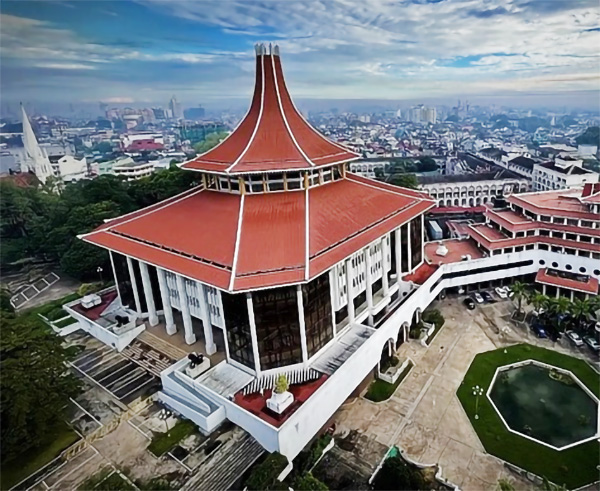
Keynote Address Delivered at the International Research Conference of the Faculty of Law, University of Colombo, on 12 December 2025.
1. The Policy Dilemma
One of the great challenges of modern public law is to reconcile traditional principles relating to the rule of law and the separation of powers with the exigencies of crises which threaten the destruction of society itself. To what extent must protective mechanisms developed by systems of law over the ages give way to the need for physical survival in the throes of life-threatening crises? What is the right balance to be struck, as a matter of public policy?
The classic statement is by John Locke, who insisted that, in emergencies, the government should have legally unfettered power “to act according to discretion, for the public good, without the prescription of the law, and sometimes even against it” (Second Treatise of Government). This is an ancient idea which goes back to Roman times, when Cicero, in his famous oration, Pro Milone, declared: “Inter arma silent leges” (“Amid the clash of arms, the laws are silent”).
This received expression in the present century in the work of Carl Schmitt, who insisted that “The sovereign is he who decides on the state of exception” (Political Theology:Four Chapters on the Concept of Sovereignty). According to him, not only is the sovereign’s authority untrammelled during emergency, but the declaration of emergency is his right alone, dependent solely on the exercise of his subjective judgment. This unqualified power springs from the supreme law of nature—-the safety of the people.
Judicial pronouncements across the world explicitly reflect this point of view. Justice Story, on behalf of the Supreme Court of the United States, famously declared: “The question arises, by whom is the exigency to be judged and decided? We are all of opinion that the authority to decide whether the exigency has arisen, belongs exclusively to the President, and that his decision is conclusive upon all other persons” (Martin v. Mott).In Ghulam Sarwar v. Union of India, Subba Rao CJ, speaking for the Supreme Court of India, observed: “The question whether there is grave emergency is left to the satisfaction of the Executive, for it is obviously in the best position to judge the situation”.
There is, however, equally emphatic opinion to the contrary. Khanna J, in a celebrated dissent, was scathing in his denunciation of the opposite approach: “The position would be that, so far as executive officers are concerned, in matters relating to life and personal liberty of citizens, they would not be governed by any law, they would not be answerable to any court, and they would be wielding more or less despotic powers” (Additional District Magistrate, Jabalpur v. Shivakant Shukla).
These competing postulates have been articulated with equal passion.
II. A Landmark Pronouncement by the Supreme Court of Sri Lanka
The Supreme Court of Sri Lanka had recently to deal with this issue frontally (Ambika Satkunanathan v. Attorney General). This is a watershed decision because, for the first time in our legal history, the Supreme Court held that an Acting President of the Republic had violated the fundamental rights of the People, enshrined in the Constitution, by the declaration of a State of Emergency.
The circumstances against the backdrop of which this historic ruling was made, are well known. A serious depletion of foreign reserves resulted in a severe shortage of basic amenities like fuel, cooking gas, electricity, staple food items, and medicine. In the context of an unprecedented default in the repayment of foreign loans and significant depreciation of the rupee, extended power cuts and galloping inflation led to acute economic hardship. These circumstances culminated in unrest on a scale never seen before on the Island.
Violence included the brutal murder of a Member of Parliament, the torching of residences of the Prime Minister and more than 70 other political personalities, forcible occupation of the Presidential Secretariat, the President’s official residence and the Office of the Prime Minister, with almost a million people gathered in Colombo demanding the resignation of the President. The elected President had fled the country, and a date had been set for an urgent meeting of Parliament to elect the President in accordance with procedure spelt out in the Constitution. An unruly mob had encircled Parliament, threatening to prevent this meeting from taking place. This was the situation in which Acting President Ranil Wickemesinghe declared a State of Emergency.
He did so in terms of provision in the Public Security Ordinance, which empowered him to take this action, if he was of opinion that this was “expedient in the interests of public security and the preservation of public order, or for the maintenance of supplies and services essential to the life of the community”(section 2).
The decision was that of a divided Supreme Court. The majority consisted of Murdu Fernando CJ and Yasantha Kodagoda J, while there was a vigorous dissent by Arjuna Obeyesekere J. The minority held that the circumstances warranted the opinion entertained by the Acting President, while the plurality declared themselves prepared to make this assumption. This, then, was common ground. The difference of opinion pertained to another vital issue.
Once the Acting President (hereinafter referred to as the President), had reached this conclusion, he had four optional courses of action available to him:
(i) He could have recourse to the routine law, principally the provisions of the Penal Code and the Criminal Procedure Code, to deal with the situation;
(ii) He could invoke Part III of the Public Security Ordinance, which would enable him to take particular actions such as calling out the Armed Forces to supplement the Police, prevent public gatherings on highways and in the vicinity of bridges and other specified locations, and declare curfew. These measures could be taken, short of proclamation of a State of Emergency;
(iii) He could take the “drastic step”, under Part II of the Public Security Ordinance, to bring into force the provisions contained within that section, in terms of which an Emergency could be declared, applicable to the whole Island;
(iv) While declaring an Emergency under Part II, he could confine its operation to particular parts of the Island.
This is where the difference of opinion between the plurality and the minority of the court manifested itself. The majority was of opinion that the President’s satisfaction relating to the existence of objective conditions justifying declaration of Emergency did not automatically entitle him to go the full length of bringing into being a nationwide Emergency under Part II, but obligated him further to consider whether measures of a more limited nature, contemplated by Part III, would be sufficient to deal effectively with the situation.Failure to do so, according to their ruling, would involve a breach of the Constitution.
By contrast, the minority was convinced that “Once the President has come to the conclusion that a state of public emergency exists, there is no purpose in mandating a consideration of other options”, and that “Requiring the President to embark on whether the ordinary laws or other various provisions or options would be adequate to deal with a public or national emergency, would be unreasonable and an unprecedented step”. On this basis, the minority held that the President’s actions were entirely within the Constitution, and entailed no liability for contravention of fundamental rights.
A great deal hinged, in practical terms,
on the divergence between these points of view.
III. Categories of Emergency: Uniform or Disparate Rules?
Contemporary trends in the law acknowledge marked differences in scale, intensity, and duration among types of emergency which precipitate varying degrees of government paralysis.
South African law incorporates one comprehensive definition of a State of Emergency, capable of invocation when “the life of the nation is threatened by war, invasion, general insurrection, disorder, natural disaster, or other public emergency” (Constitution, Article 37(1)(a)). Preferable, by far, is the position under the Emergencies Act of Canada, which recognises four different kinds of emergencies— natural disasters, threats to public order, international emergencies, and states of war (Section 18(2)). This enables different degrees of Parliamentary scrutiny and control.
The Constitution of India provides another example of this approach. Article 352 envisages a threat to the security of India or any part of the country by reason of war, external aggression or armed rebellion, while Article 356 contemplates a failure of constitutional government in any Indian state, and the context of Article 360 is jeopardy to the financial stability or credit of India.
In the spectrum of gravity, peril to the very existence of the state, in the degree present in the Sri Lankan situation, attracts the highest concern. In circumstances of potential government breakdown, “facile distrust” is not the recommended counsel. The courts of India have cautioned that “When there is a crisis situation, it is necessary to trust the government with extraordinary powers in order to enable it to overcome such crisis” (Bhagvati J. in Shivakant Shukla).
Undue concern about a lawless situation, typified by unbridled executive power, is not realistic. Emergency legislation has rightly been characterized as “extra-legislative legislation”. Far from there being a legal vacuum, systems of law have furnished practical safeguards, while enabling public order to be maintained.
One of these is the imaginative “super-majority escalator” technique, characteristic of South African law. Only a simple majority of Parliament is required to approve a State of Emergency operative for a maximum period of 21 days, and to extend it up to 3 months. Beyond that, a 60% majority is compulsory for further extensions (Article 37). Here, then, is a successful reconciliation of competing objectives.
Article 16 of the Constitution of the Fifth Republic in France empowers the President to determine not only the sufficiency of conditions warranting the declaration of a State of Emergency, but also its appropriate duration. Restraints on Presidential power in France are weak because the President, although required to consult the Conseil Constitutionel (Constitutional Court), is not bound by its advisory opinion, in the event of contrary advice.
Relative amplitude of Presidential power in emergency situations in France has been justified by a prominent French jurist, François Saint-Bonnet, on the basis that the curtailment of emergency powers at the disposal of the Executive carries the risk of deprivation of the very tools which the government finds indispensable to combat the threat.
Germany’s Basic Law, although wary of emergency powers because of the harrowing experience of Article 48(2) of the Constitution of the Weimar Republic, which paved the way for the rise of Hitler, nevertheless does not balk at recognizing “internal emergencies” which enable intervention by the Executive, albeit subject to control by the Federal Parliament.
Constitutional provisions in different jurisdictions, irrespective of the approach selected, envisage substantial executive power in times of emergency, curtailed by surveillance on the part of the elected Legislature.
IV. Restraints on Judicial Intervention
The decided cases in many countries are replete with examples of indicia which concede to the Executive great latitude in these contexts. The recurring feature is the urging of restraint in the exercise of judicial review in keeping with a suitably benign construction, consistent with constitutional standards. This is reflected in unimpeachable academic authority, as well.
It has been insisted that executive decisions “should be taken seriously as a bona fide attempt to solve whatever social problem they set out to tackle”(Aileen Kavanagh).The caution has been administered that judges should exercise great caution before concluding that the government has violated constitutional rights(Prof. T. R. S. Allan) and,in public emergencies threatening the life of the nation, elected officials should be permitted “to err, if at all, on the side of safety”(Lord Bingham).The courts “should resist the temptation to substitute their own preferred solutions to questions of public policy”(Allan).
This is so, for a number of reasons. One of them is that the public authority is entitled to latitude because it has “a kind of responsibility to advance the public interest that a court does not have”(Brooke L.J.).This is reinforced by other considerations. For instance, possession of special expertise by the executive authority is an important factor.
The nature of the subject matter, for this very reason, has a vital bearing on the issue. Judges have been conscious that “the more political the question is, the more appropriate it will be for political resolution, and the less likely it is to be an appropriate matter for judicial decision”(Lord Bingham).
A responsible and representative system of democratic governance brings into sharp focus “the degree of democratic accountability of the original decision maker, and the extent to which other mechanisms of accountability may be available”(Murray Hunt).Basic values of constitutionalism identify Parliamentary controls as infinitely preferable, in this regard, to judicial intervention.
This has to do with the nature and legitimate confines of the judicial function. Mirza Beg J, speaking for the Supreme Court of India, has candidly conceded that “the judicial process suffers from inherent limitations”(Shivakant Shukla).This is essentially because a court “can neither have full and truthful information, nor the means to such information”(Chandrachud J in Shivakant Shukla),especially in respect of classified information.
An absolute imperative is that the distinction between judicial review and substitution of judgment must be scrupulously observed. Admittedly contextual, this principle is of overriding significance because it is “wrong to expect executive bodies to replicate the style of analysis adopted by courts in determining allegations of violation of rights”(T. R. S. Allan).
It is crucial for the rule of law that the dividing line between these two distinct functions should not become inadvertently blurred. It is not necessary for the public authority to address itself to the same legal arguments as the court(Court of Appeal of England in the Begum case),the judicial function being restricted by the consideration that “the court is usually concerned with whether the decision maker reached his decision in the right way, rather than whether he got what the court might think to be the right answer”(Lord Hoffmann).
The raison d’etre underpinning executive intervention in these extraordinary situations should be constantly borne in mind. The reality is the absence of a practical substitute. “Neither the legislature nor the judiciary is capable of swift, energetic action, which leaves the executive by default as the authoritative body”(David Dyzenhaus).For this inescapable reason, there has been constant emphasis that executive actors “should not be deterred from engaging in the very activity needed,and contemplated, to deal with the crisis”.
The overarching object of policy is the preservation of public confidence. “The faster and more effective the response, the smaller the overall damage to society, as a whole. The best way for government to respond to these fears is to do something large and dramatic to reassure the populace”(Bruce Ackerman).
The weight attaching to these elements of public policy is self-evident. (To be continued)
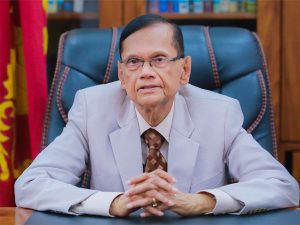 By Professor G. L. Peiris
By Professor G. L. Peiris
D. Phil. (Oxford), Ph. D. (Sri Lanka); Rhodes Scholar,Quondam Visiting Fellow of the Universities of Oxford, Cambridge and London; Former Vice-Chancellor and Emeritus Professor of Law of the University of Colombo.
Features
90th Anniversary of LSSP and leftism in Sri Lanka

The Lanka Sama Samaja Party was formed on the 18th of December 1935. Its four leaders were Dr. N. M, Perera, Dr. Coivin R, de Silva, Philip Gunewardena and Leslie Goonewardene, who also became the General Secretary. (Prior to this, in 1933, the Wellawatte Mills strike first led to their getting together in action). It must be mentioned that The LSSP was the first properly constituted political party in the country. It was also the first genuine Left party and its political philosophy was based on Marxism-Leninism. It took the name ” Sama Samaja”, which means ” Equal Society”, as, at that time, the people in Sri Lanka were unfamiliar with the terms Socialism and Communism. It was quickly accepted by the people and, despite the use of state power and thuggery against the LSSP by the local capitalist class, backed by the British rulers, the Party rapidly gained popularity among the people. In the General Election of March 1936 Dr. N. M. Perera was elected to represent the Ruwanwella electorate and Philip Gunawardena the Avissawella electorate. Unfortunately, Dr. S. A. Wickramasinghe was unable to retain Akuressa, which he had won in the 1931 Election, and Leslie Goonewardene failed to win Panadura due to the use of caste and money unfairly against him. Leslie, throughout his political career, refrained from descending to such a low level of politics But the LSSP stand helped in the process of uniting and politicisation of the people which was necessary to generate the confidence of the people in their ability to win Complete Independence through the democratic process.
Throughout its history a major role in the success of the LSSP was its provision of support to the struggles of the working class to win its rights. Dr. N. M. Perera formed the Ceylon Federation of Labour and, as its President, he organised the trade union movement to focus on winning their genuine demands as a class. He negotiated with the employers and won many demands across the table, and resorted to strike action as a last resort. He won the respect of both employees and employers as a leader who did not misuse the trade unions for personal vendettas. He used Parliament in a responsible manner to fight on behalf of the workers, while informing the public who suffered as a result of the strikes that the demands were just, and winning their support as well. The LSSP unions have maintained these values and continue to serve the working class
The LSSP was aware of the problem of poverty leading to hunger as a major factor that affected the life of a majority of our people. A survey done at the MRI, about two years ago, showed that 63% of families had an income below the poverty line. They could not have three adequate meals per day. Some had two meals and others only one that met their nutritional needs. The children and mothers were particularly vulnerable. The malnutrition level in that study was 14.3%. But the situation appears to be worse now. The Suriyamal Movement led NM to one of the worst affected areas, Kegalle. The focus was on malaria eradication, but they had to also address the problem of poverty and hunger. Rice, dhal and coconut sambol were provided. NM came to be known as “Parippu Mahaththaya” as a result. The LSSP is reviving the Suriyamal Movement which has become an urgent need after the Climate Change. Any help will be welcome.
We celebrate Independence Day alone, but India also celebrates Republic Day. It is the latter that gave India sovereignty, without which independence is empty. They won it within three years, with Ambedkar drafting the Republican Constitution. The LSSP kept on pressing for it but the comprador capitalist class, led by the UNP, kept delaying as they were happy with Dominion status. The LSSP joined the SLFP and CP to form the coalition government, led by Sirimavo Bandaranaike, in 1970, and Dr. Colvin R. de Silva was made the Minister of Constitutional Affairs. He finally drafted the Republican Constitution in 1972. Sri Lanka took 24 years to do this and we can hold our heads up as we are now politically a truly independent sovereign nation. But we remain a poor underdeveloped country with widespread unemployment and underemployment, especially among the youth. The number of those in poverty is rising while the rich are becoming super rich. The rich/poor gap is widening and it may explode. It is sad to see that Sri Lanka is far away from the Welfare State that the LSSP, led by Dr. Perera, strove to build. As Minister of Finance, he kept the cost of living down, balanced the Budget and did not tax the poor. He had a high direct tax on those who could afford to pay this. Unlike now, the priority was given to use the limited forex to buy essential medicines,not luxury vehicles.
As Minister of Science and Technology, I started the Vidatha Movement to provide the technology and finance for Small and Medium Enterprises (SMEs) countrywide, one centre headed by a science graduate in each division. I am told that more than 50,000 entrepreneurs have emerged marketing their products sustainably. More than one thousand are exporting their products. I appeal to the NPP government to continue to support them. We must develop into an industrial nation if we are to emerge from poverty. I and the LSSP will give all support. By the way, our armed forces can defend our country. We do not need American forces.
by Prof. TISSA VITARANA
(Leader and General Secretary, LSSP)
-

 Business7 days ago
Business7 days agoCabinet approves establishment of two 50 MW wind power stations in Mullikulum, Mannar region
-

 Features4 days ago
Features4 days agoWhy Sri Lanka Still Has No Doppler Radar – and Who Should Be Held Accountable
-

 Features6 days ago
Features6 days agoDitwah: A Country Tested, A People United
-

 News6 days ago
News6 days agoRs 1. 3 bn yahapalana building deal under investigation
-
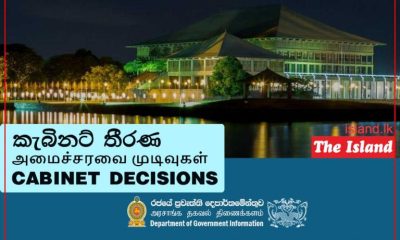
 News7 days ago
News7 days agoCabinet approves the transfer of the constructions and land reserved for the Kiinniya University to the Ministry of Foreign Affairs, Foreign Employment, and Tourism
-

 Business6 days ago
Business6 days agoFluctuating fortunes for bourse in the wake of selling pressure
-

 Opinion6 days ago
Opinion6 days agoComfort for some, death for others: The reality of climate change
-
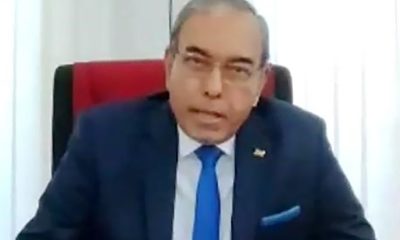
 News6 days ago
News6 days agoFormer SAARC SG Esala Weerakoon calls for ‘South Asian Climate Compact’




